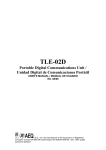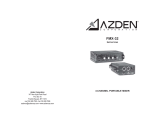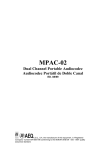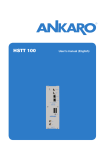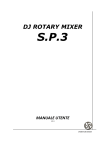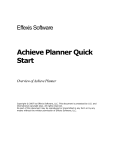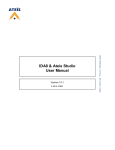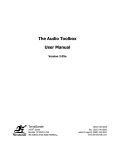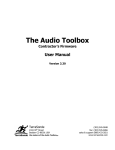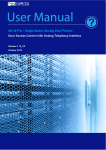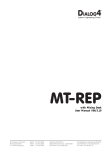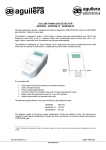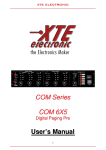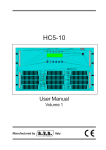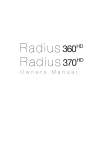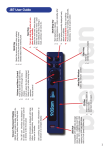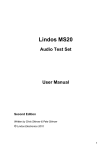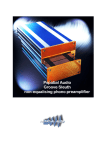Download TLE-02D Portable Digital Communications Unit
Transcript
TLE-02D Portable Digital Communications Unit USER’S MANUAL ED. 08/99 A.E.Q., S.A. the manufacturer of this equipment, is “Registered Company” number ER-080/1/96 conforming to the AENOR UNE EN - ISO - 9001 quality assurance standard. INDEX 1. DESCRIPTION OF THE EQUIPMENT 1.1. BASIC DESIGN CONCEPTS 1.2. SPECIFICATIONS 1.3. FUNCTIONAL DIAGRAM 2. POWER SUPPLY 2.1. GENERAL 2.1.1. UNIT POWER SUPPLY 2.1.2. SWITCHING ON 3. INSTALLATION AND WIRING 3.1. DESCRIPTION OF THE FRONT PANEL 3.2. DESCRIPTION OF THE REAR PANEL 4. DESCRIPTION OF CONTROLS 4.1. VISUALISATION AND USER INTERFACE CONTROL SECTION 4.2. DIALLING SECTION 4.3. MONITOR AND LEVEL CONTROL SECTION 5. ISDN MODE USER INTERFACE 5.1. START-UP 5.2. ACCESS TO THE ‘PHONE BOOK AND RECALL 5.3. ACCESS TO CODIFICATION CHANGING 5.4. MANUAL DIALLING 5.5. CALL GENERATION 5.6. CONNECTION ESTABLISHED 5.6.1. DATA CHANNEL 5.6.2. VUMETER MODE 5.7. GENERATION OF DTMF TONES FOR REMOTE CONTROL 6. TLE MODE USER INTERFACE 6.1. START-UP 6.2. EXTENDED OPERATION MODE 6.3. ACCESS TO THE ‘PHONE BOOK AND RECALL 6.4. CALL GENERATION 6.5. GENERATION OF DTMF TONES FOR REMOTE CONTROL 7. UPGRADING THE INTERNAL SOFTWARE (FIRMWARE UPGRADE) 7.1. SYSTEM DESCRIPTION 7.2. REQUIREMENTS OF THE PC USED FOR UPGRADING 7.3. CONNECTIONS FOR CONTROL COMPUTER 7.4. FIRMWARE UPGRADING 8. TECHNICAL SPECIFICATIONS APPENDIX 1: GUIDE TO RAPID USE 1. TO ESTABLISH COMMUNICATION 1.1. CTN MODE 1.2. ISDN MODE 2. EQUIPMENT USE ONCE COMMUNICATION IS ESTABLISHED APPENDIX 2: AEQ WARRANTY TLE-02D Portable Digital Communications Unit 2 1. DESCRIPTION OF THE EQUIPMENT 1.1. Basic design concepts The AEQ TLE-02D Portable Communications Unit is designed in a compact format offering easy to use unique features such as an audiocodec, a digital telephone hybrid, a frequency extender and a portable mixer. The AEQ TLE-02D is the only equipment in the market offering such a high integration in a single portable unit. Exclusive design, equipped with a Double Power Supply System through standard dry cells or external powering, allowing a fantastic operation autonomy. Dial-pad with selectable Pulse/DTMF tones. Auxiliary Output with level control. RJ-45 connector for ISDN lines and RJ-11 for Analogue Telephone Lines. Four Wires always available. Selection of routed signals to Auxiliary Output. The AEQ TLE-02D - the ideal portable unit for remote broadcasting operation - will connect several On-Air commentators in the field to your studio by digital or analogue telephone lines. The advanced technology in the AEQ TLE-02D will provide you with a cost-effective remote capability, simple to install and easy to operate. 1.2. Specifications: • Two microphone and one micro/line inputs, with COMBO connectors for XLR3 and Jack ¼’’. • Independent analogue mix level control for each input channel. • The mixer signal is treated with an analogue compressor/limiter to avoid clipping in the digital stages. • Two stereo headphone outputs, with independent level and mix controls. • Monitoring Mix control over headphones and Auxiliary Output Control allowing to monitor only Send (TX), only Return (RX) or a mix of them to any relationship. • Monitoring of the Auxiliary Input, with trim level. • Dialling with Sub-Adressing Capability (when using ISDN (where this is available). • 4 Wire Input/Output Interface • Backlit LCD display. Indication of status, dial numbers, phonebook entries and menu options. • Acoustic signalling of the incoming calls either in ISDN or Analogue Telephone Lines. • Alphanumeric Phonebook with up to 256 entries. • Menu configuration using only two buttons • Software up-grade available through Flash-RAM technology. • Transmission modes: ISDN Mode: Available audio coding algorithms: • G.722, Statistical framing 64 Kbps. Bandwidth: 20Hz – 7KHz • G.722 H221/H242 framing 64 Kbps. (including Auxiliary Data Channel transport), Bandwidth: 20Hz – 7KHz • G.711/64 Kbps: A and µ Laws, for connection with standard telephone numbers • E-ISDN Protocol Analogue Telephone Line Mode: • Digital Hybrid with Frecuency Extender and echo cancellation (64dB rejection), dial pad for tone or pulse. • Bandwidth: - Without Extender: 300Hz - 3300Hz - With Frequency Extender: 50Hz - 3050Hz TLE-02D Portable Digital Communications Unit 3 1.3. Functional diagram Schematic functional diagram of the Audio Codec. TLE-02D Portable Digital Communications Unit 4 The signal generated in each of the three channels (2 microphone and 1 micro/line) pass to the mixer circuit and then, after passing through a limiter, are sent to the A/D converter on one hand, and to the foldback circuit on the other. The foldback circuits allow the continuous adjustment from only Program go to Return signal, i.e. any mix between both. The channel levels are adjusted by the Mic1, Mic2 and Mic/Lin potentiometer. The signal, once it has been limited, passes to the analogue-digital converter and is processed in the DSP, that is programmed for transmission by ISDN or CTN (Commuted Telephone Network). In the former case, the signals reach the TA (terminal adapter) which is controlled by the communication controller, this accepts user instructions entered through the keyboard with this information being shown on the alphanumeric display. In the latter case, the signals are sent to the CTN telephone socket through the D/A converter and analog hybrid instead of the ISDN adapters (TA). In both cases, a return signal travels in the reverse direction from the communication interface to the DSP, from where it passes to the D/A converter that generates the Program return signal. This signal may be heard in the commentator’s headphones. The Unit in turn has a data and control port, to send and receive auxiliary data and for equipment configuration and upgrading. TLE-02D Portable Digital Communications Unit 5 2. POWER SUPPLY 2.1. General The power supply connector (1) is found on the rear panel of the unit. 1 2.1.1. Unit power supply The AEQ TLE-02D can be powered by standard batteries or an external source. If an external power supply is to be used it must be connected to the 12V DC-INPUT (1). The power supply unit supplied with the equipment, or an alternative unit capable of delivering the correct voltage and current, must be used. The cable supplied with the power supply unit is fitted with a standard pin plug, which is lockable to prevent accidental disconnection. If a standard alkaline battery power supply is to be used: 8 standard 1.5V AA (LR6) alkaline batteries must be fitted to the AEQ TLE-02D, this will allow approximately 1h30m autonomy at 100% yield. AEQ recommends DURACELL batteries. 2.1.2. Switching on Before connecting the power supply ensure the on/off switch is in the OFF position. Once the lockable plug is correctly connected to the unit, it should be connected to the network supply. Turn the power supply switch to ON. If all the previous steps have been correctly followed, the display will illuminate, indicating that the equipment is receiving power. TLE-02D Portable Digital Communications Unit 6 3. INSTALLATION AND WIRING To clarify the installation and wiring process it is necessary to be familiar with the connectors and configurable elements. 1 7 5 8 2 3 4 9 6 10 3.1 Description of the front panel The following controls are mounted on the front and Control panels; these are explained later: (1) The backlit LCD display (2) The numeric keyboard (3) The Multifunction and Audiocodec Control Keys (4) Mic and Mic/Lin channel Input level controls (5) Headphones Output level controls (6) Auxiliary Output Level control (7) Auxiliary Output and Heaphones Output Mix controls (8) ISDN-CTN indicators (9) Power supply switch (ON) (10) Low Battery indicator TLE-02D Portable Digital Communications Unit 7 3.2. Description of the rear panel 12 4 5 10 11 2 3 1 6 8 7 9 A series of combo XLR3-Jacks (1 and 2) are found on the front panel, one is connected to each channel of each input. This type of connector allows the connection of male XLR3 or ¼” male telephone type jack plugs, therefore admitting balanced or asymmetric signals. The headphone outputs (4) are provided with ¼” stereo telephone jacks. The Mic/Tape channel possesses a micro/line level selector switch (3). The numbered elements and their use are described in the following selection (1) (2) (3) (4) (5) (6) (7) (8) (9) (10) (11) (12) Microphone Inputs 1 and 2 Micro/Line Input Mic/Line switch Heaphones Output 1 and 2 RS232 Data channel and Control port. Sub-D 9 Female RJ45 ISDN line connector RJ11 Analogue Telephone Line (CTN) connector Mode selector switch ISDN (ISDN) – Analogue Telephone Line (CTN) Dial mode selector switch Pulse – DTMF Tones in CTN mode 4 Wire interface Auxiliary Input trim level Power supply connector (DC-INPUT) Microphone Inputs 1 and 2 The microphones are normally supplied with the appropriate connectors for direct connection to the Audiocodec. The connector wiring is shown below: XLR connectors 1: ground 2: microphone V+ 3: microphone V- ¼” Jack connectors sleeve: ground tip: microphone V+ ring: microphone V- Mic/Line Input A cable with either a male XLR3 or ¼” stereo Jack must be used. The connector wiring is the same as that for the microphone inputs. Mic/Line switch To select microphone input level, the switch is set to the rest position (switch button out), and to select line input level, the switch is set to the activated position (switch button in). TLE-02D Portable Digital Communications Unit 8 Heaphones Outputs A standard TRS ¼” headphone output jack is fitted. The connector wiring is shown below: ¼” Jack connectors Tip: Left earpiece Ring: Right earpiece Sleeve: Common ground Connections for Control and Data port (RS232 port) The unit has a female DB 9 chassis mounted connector for configuration and transmission of auxiliary data in conjunction with an external computer communicating through RS 232 protocol (a cable fitted with male connector must therefore be used). The active contacts are: TX 2 RX 3 GND 5 A Pin-to-Pin Male-Female cable must be used and connected to the PC serial port. For details of the PC serial communication port, consult the user manual supplied with the computer. RJ45 chassis connector wiring The RJ 45 connector connects the terminal adapter, which is included in the equipment, with the ISDN access point (Network terminal). This connector wiring is standard according to the following diagram. Frontal View For connection to the ISDN line socket the cable supplied with the equipment, or similar, must be used. Cable Number 1 2 3 4 5 6 7 8 Connections ------------------------------------- Tx Rx Rx Tx V+ VV+ V- RJ11 chassis connector wiring: Connection to the telephone line is by 4 contact RJ11 type connector. The telephone line must be connected according to the standard for RJ11 connectors (using the two centre contacts, 2 and 3). For connection to the telephone line socket the cable supplied with the equipment, or similar, must be used. TLE-02D Portable Digital Communications Unit 9 Selector Switch for ISDN-Analogue Telephone Line Mode (MODE SELECT ISDN/ANALOG TELEPHONE LINE): This selects the required line type (ISDN - CTN). Important: To change the line type selection the equipment must be switched-off and restarted with the new configuration. . Dial mode selector switch Pulse – DTMF Tones in CTN mode: This switch selects the dial mode by Pulse or by DTMF Tones, allowing generating DTMF tones to effect remote control operations in mode CTN. 4 Wire Interface Full Bandwidth (20Hz-20KHz). Whether the unit is used as an Audiocodec on ISDN or as a portable Telephone Hybrid on CTN, the transformed balanced 4W input/output is always available, being operative to use it simultaneously with any of the two modes. The return input has a level adjustment (TRIM) and it is permanently routed to the headset outputs. Therefore it can be used for the connection of other Auxiliary signals that could be required to be monitored by the reporters, such as Guides, Cue, P.A., International Sound, etc. The Aux. out has also a mix control for the send and return signals (SOURCE), in this way increasing the possibilities of the equipment which can be used as per the following examples: - As a conventional 4W circuit, or a pre-mixer, setting the associated control knob SOURCE in TX position. - As a recording output, setting the associated control knob SOURCE in an intermediate position TX/RX. This way, both program and return signals are available at the Output. - As an auxiliary output of the digital hybrid, setting the associated control knob SOURCE in RX positions. This way the unit can be connected to other equipment or to a loudspeaker in order to use the hybrid as a hands-free telephone. 4 Wire Interface Auxiliary Input level adjustment: The 4 wire interface auxiliary input level can be adjusted with the Trimmer (LEVEL TRIM) located next to the interface. Power supply: Power is delivered to the Unit by the supplied AC-Adaptor or another suitable power supply, through the DC-INPUT connector. DC Voltage Polarity: Current: Connector: Power consumption: 12 V. V+ : centre pin; V- : exterior 0.52 A. @ 12V Standard cylindrical DC, 2 mm internal, 6 mm external Approx. 6W. If the unit is to be powered by batteries, 8 standard 1.5V AA (LR6) alkaline batteries must be fitted. The batteries are inserted through the top of the unit. AEQ recommends DURACELL batteries. Correct polarity must be observed. Batteries must be inserted as indicated in the diagram in the battery compartment. TLE-02D Portable Digital Communications Unit 10 4. DESCRIPTION OF CONTROLS Control Panel From the operational point of view, the control panel is divided into three sections: • Visualisation and User Interface Control Section • Dialling Section • Monitor and level control section Fig. 4.1 Position of the control panel elements. 4.1. Visualisation and User Interface Control Section The status of the AEQ TLE-02D Audiocodec (connection, codification, number dialled, etc.), as well as the configuration, can be visualised on the Display (2 lines X 16 characters). Access is gained to the various configuration menus, dialling, telephone book, etc. by using the four pushbuttons (Two Multifunction Keys, OK, CANCEL) situated under the visual Display. The upper line of the Display is for user information and the lower line shows the function associated with each of the two Multifunction keys. The use of the Multifunction keys is explained in section 5 and 6 “User Interface”. 4.2. Dialling Section The dialling section consists of the numeric keyboard, for entering the number to be dialled. TLE-02D Portable Digital Communications Unit 11 4.3. Monitor and level control section This section of the control panel is comprised of eight potentiometers. These allow the AEQ TLE-02D to adjust the mix levels of each input (two microphone and one mic/line) with independent level adjustment for each, and with level adjustment for each output: two headphones and one auxiliary output, therefore the adjustment of the mix heard in the outputs is independent for both headphones and the auxiliary output: Send, Return, or any intermediate mix between the two. TLE-02D Portable Digital Communications Unit 12 5. ISDN MODE USER INTERFACE ISDN Mode User Interface Flow diagram: TLE-02D Portable Digital Communications Unit 13 5.1. Start-Up: The following window appears when the equipment is started: (0) TLE-02D AEQ ISDN MODE Two seconds later, an information windows appears with the firmware versions downloaded to the different modules (Microcontroller, DSP and TA) of the AEQ TLE-02D, besides a PAUSE label. When the yellow key next to that label is pressed, it is sustituted with the label CONT, keeping the information of the versions until CONT is pressed. MCUV1.10 DSPV1.01 TAV 1.04 PAUSA If you have not pressed PAUSE, two seconds later the unit passes to the stand-by window (initial window): ISDN G722 STAT P-BOOK CHCOD (1) In the initial window (1), the default codification mode selected for the establishment of the circuit connection appears on the top line of the display. The function associated with each of the multifunction keys appears on the bottom line of the display. “P-BOOK” “CHCOD” In this situation the user can perform three operations: 1.- Activating “P-BOOK” (Telephone Book) displays the ‘phone book which is included in the unit. 2.- Activating “CHCOD” (CHANGE CODIFICATION) accesses the window which allows the mode of connection codification to be changed 3.- Finally, if the numerical keyboard is used in the stand-by state, the manual number composition window appears and the user can manually enter a telephone number and make a call. The following describes the use of the above functions: 5.2. Access to the Phone Book and Recall On activating “P-BOOK” the following window appears: LAST NUMBER DIALLED UP DOWN (2) The last number dialled is shown on the top line. . If the ‘phone book is entered from start-up no number is displayed, if any calls have been made, the last number dialled will be seen, window (2). Recall is effected using the key. The “UP” and “DOWN” keys are used to enter the ‘phone book and pass through the 256 Phone Book entries. TLE-02D Portable Digital Communications Unit 14 The first entry stored in the ‘phone book’s non-volatile RAM memory appears on the upper line of the display. Each ‘phone book entry has three fields: Position number field: A001......A256, to designate the position of the entry in the ‘phone book. LABEL field: maximum 10 characters, to give a name to the entry. NUMBER field: maximum 16 digits, to save the telephone number. If the ‘phone book registry is empty only the registry number is displayed, and the label field does not appear. The user can select the desired entry by using the “UP” and “DOWN” keys to pass through the 256 available registers. Using the “DOWN” key will display entry number 1, and using the “UP” key will display entry number 256. By pressing “UP” or “DOWN” for more than two seconds allows a fast search whithin the P-Book entries in the selected direction (up or down). Pressing “CANCEL” will return to the stand-by window (1). The “OK” key validates the entry selected by the user and passes to window (3): A001 LABEL EDIT NUMBER The (3) key is pressed to establish the connection. Activating “NUMBER” displays the telephone number associated with this ‘phone book entry (3’). TELEPHONE NUMBER Pressing “CANCEL” will return to the previous window (3). The “EDIT” key summons the edit/modify window for the selected entry. First, the number associated to the entry in question is edited (4). TELEPHONE NUMBER <= => (4) The telephone number associated to the selected ‘phone book registry appears on the top line of the display. If the said registry is empty, the top line of the display will be blank (the cursor position is marked by the corresponding display position blinking. Initially the cursor is displaced to first position on the display). The numerical keyboard enters the number directly onto the top line of the display and automatically advances the cursor. The “⇐“ and “⇒“ keys move the cursor backwards (and erases the digit above the cursor) or forwards respectively to modify the numbers which have been introduced. Finally, the “OK” key validates the number and passes to the label edit window (5). A001 LABEL <DEL <= => (5) If the registry is empty, the registry number is shown on the top line of the display and the cursor blinks in the first modifiable position, with the “LABEL” field remaining blank. TLE-02D Portable Digital Communications Unit 15 The characters which form the label are selected using the “⇐ ⇒“ key to pass through the table containing all the alphabetical and special characters such as blank space (“ “) and hyphen (“-“). (“A, B,...,Z, -, ). When starting from an empty registry, pressing “⇐ ⇒“ will show “A“. The numerical keyboard is used to introduce the “*” or the “#” and numerical characters into the label. It is only necessary to pause for one second after pressing “⇐ ⇒“ or the numeric keyboard to select the desired character and pass to the next position in the label. The cursor automatically advances to the next position. The “<DEL” key deletes the character and moves the cursor one step backwards. Finally, in window (5), the label associated with the selected ‘phone book register is definitively validated using the “OK” key, and is stored in non-volatile RAM memory and the stand-by window (1) appears. 5.3. Access to codification changing Activating the “CHCOD” key when in the stand-by state (1), opens the codification change window (6): ISDN G722 STAT? UP DOWN The user can view the different codification modes available by using the “UP” and “DOWN” keys to pass through the table: 64 Modes: ISDN G711 A-LAW ........................A Law. ISDN G711 µ-LAW ........................µ Law. ISDN G722 STAT ..........................G722 Statistical. ISDN G722 H221 ...........................G722 H221/H242 If the “DOWN” key is pressed in the state represented by (Fig. 6) the legend “ISDN G722 H221“ will appear on the top line of the display, and if “UP” is pressed the message “ISDN G711 µ-LAW” will appear. Next to the label of each mode, it appears a blinking quotation mark. Pressing the “CANCEL” key will return to the initial window without modifying the current codification setting. Pressing “OK” validates the selected codification mode, the quotation mark stops blinking and the stand-by window (1’) will appear with the new codification mode being shown on the top line of the display. For example, if “ISDN G711 µ-LAW” is selected, the following will be seen on returning to the stand-by state: ISDN G711 µ-LAW P-BOOK CHCOD (1’) 5.4. Manual dialling If the numeric keyboard located on the front of the unit is used when in stand-by status, the dialling window will open (7): (7) 9______ <DEL The number will appear on the top line of the display as it is entered. TLE-02D Portable Digital Communications Unit 16 Using the “<DEL” key will delete the last digit entered. Pressing the key will initiate the call to the number that has been manually entered. The “CANCEL” key may be used to return to the stand-by window (1) if it is not desired to establish communication at this time. 5.5. Call generation Activating the key in any of the windows represented by Fig. (3) and (7), initiates the call generation process, which results in the display of a release of call, or successful connection message. When communication is initiated, window (8) will appear: CALL IN PROGRESS (8) If the communication continues successfully and connection is established the connection established window (9) will open. PRG CON. CODIF SYNC. VU (9) This window is detailed in the following section. If on the other hand the connection cannot be established, the user will be informed of the reason for the failure. The following call release messages are issued by the equipment: i) ii) iii) iv) v) vi) ERROR: An internal error has occurred in the call generation process. NO ISDN AVAILABLE: An attempt has been made to establish communication when there is no ISDN line available. DESTINATION BUSY: The remote terminal is occupied. NO ANSWER: The remote terminal has not responded to the incoming call. CALL REJECTED: The network has rejected the call, this includes all the remaining possible causes of release. CALL NOT CONNECTED: The waiting time set for the unit to establish connection with a remote terminal has expired. The equipment will return to the stand-by window (1) following the emission of any of these release messages. 5.6. Connection established The following message will appear in the display after window (8) if the connection is established: CALL CONNECTED and the stablished-connection window (9) will appear one second later: PRG CON. CODIF SYNC. VU (9) SYNC./NO SYNC.: Connection is established an synchronised / not synchronised CODIF: Opens the codification window TLE-02D Portable Digital Communications Unit 17 VU: Opens the VU-meter mode window.. When using G722 H221/242 codification mode, the “CODIF” key is changed to “DATCHN”, since this mode allows the establishment of a data channel. The “DATCHN” key opens the window for the establishment of a data channel. The key is used to terminate the connection in the stablished-connection window (9) and the initial stand-by window (1) will return. The same happens when the remote terminal terminates the connection. 5.6.1. Data channel: This is a transparent bi-directional point-to-point 1200 baud channel. For the channel to operate correctly, the transmission configuration should be set to: – 1200 bauds – No parity – 8 data bits – 1 stop bit The data channel can be established in G722 H221/H242 codification mode, the only codification mode in the equipment that allows the establishment of an auxiliary data channel. The establishment of data channels is not permissible in the remaining modes as listed in the chart in section 5.3. If mode G722 H221/H242 is being used, the “DATCHN” appears instead of the “CODIF” key. Activating the “DATCHN” key opens window (10): TXoff TX RXoff RX (10) Pressing the “Rx” and “Tx” keys activates (On) or deactivates (Off) the transmission (Tx) or reception (Rx) of the data channel. Pressing the “CANCEL” key will return to window (9). 5.6.2. VU-meter mode: Pressing the VU key in window (9) will open the VU-meter window (11): ▓▓▓▓▓▓▓▓▓▓▓▓▓▓ ƒ)ƒƒƒO (11) The output levels from the Output channel are represented by ”▓“ characters. If the output signal level is below –22dBu the ”▓” character will not appear in the display. Each “▓“ character represents a step of 2 dBu. The “)” represents 0 dBu level. Levels above “)” are shown as +2,+4,+6dBu and finally the character ”O” which represents Program signal saturation level (+18dBu). To avoid saturation, it is advisable not to exceed the recommended input levels.. “CANCEL” is used to return to window (9). 5.7. Generation of DTMF tones for remote control. It is possible to generate and send DTMF tones to line to effect remote control operations when operating in ISDN mode and in connection established status (9). It is necessary to press the corresponding digit on the keyboard. The audio Program is cut during tone generation. TLE-02D Portable Digital Communications Unit 18 6. CTN MODE USER INTERFACE CTN Mode User Interface Flow diagram TLE-02D Portable Digital Communications Unit 19 6.1. Start-up: When the equipment is switched-on and CTN mode is selected by the switch on the rear panel, the following window will be displayed: TLE-02D AEQ ANALOG MODE and two seconds later the analogue stand-by window (1) will appear: ANALOG TELEPHONE EXTEN P-BOOK (1) When the equipment is switched-on NORMAL operation is selected by default. Pressing the “EXTEN” key changes the operational mode to EXTENDED. The stand-by window changes to show the new “NORM” key (1’). ANALOG TELEPHONE NORM P-BOOK (1’) 6.2. Extended operation mode. Typical telephone circuits have a limited band width between 300 and 4000 Hz. Unfortunately, the major part of voice energy is in frequencies below 300 Hz, and is lost during transmission over telephone lines. Telephone audio signals have their characteristic sound, the loss of voice body being the most notable, for this reason. The extended operation mode allows the transmission of frequencies between 50 and 300 Hz through telephone lines. To achieve this, the signal is subjected to a 250 Hz frequency shift before being sent, thereby improving the low frequency band quality of the signal received at the expense of the highest band. The bandwidth transmitted is, therefore, between 50 and 3750 Hz. The 250 Hz lost in the highest frequencies are not very significant given the logarithmic nature of audio frequency response. The frequency shift is performed by encoding the audio signal before it is sent to the telephone line. The suitably equipped receiver decodes the signal, that is to say, the frequency shift is reversed. The decoded signal contains the original band (50-3750 HZ) without suffering any type of degradation. In this way, a voice signal with improved clarity and depth is achieved, including during those communications that take place under the worst conditions. Switching between Extended and Normal mode is performed using the “EXTEN/NORM” key during ANALOG stand-by mode (1). 6.3. Access to the Phone Book and Recall: The ‘phone book is shared by both the equipment’s working modes (ISDN and CTN). Access is identical to that described in ISDN mode section 5.2. TLE-02D Portable Digital Communications Unit 20 6.4. Call generation: Pressing the Activating the (Off Hook) key in the stand-by window (1) will produce a dialling tone. key from any of these windows will open window (2). (2) EXTEN VU Dialling is automatic if the number is taken from the 'phone book, or is a recall which is shown on the top line of the display. Dialling can also be performed manually using the numeric keyboard. Pressing the “VU” key will open the VU-meter window to enable visualisation of the Program output level in the same way as in ISDN mode (3). Pressing the “CONN” key will return to the previous window (2). (3) ▓▓▓▓▓▓▓▓▓▓▓▓▓▓ ƒ)ƒƒƒO EXTEN CONN If (On Hook) is pressed in windows (2) or (3) once the call is established, or during dialling, the call will be terminated and the unit will return to stand-by status (1). 6.5. Generation of DTMF tones for remote control. It is possible to generate and send DTMF tones to line to effect remote control operations when operating in CTN mode and in connection established status (2). It is necessary to press the corresponding digit on the keyboard. The audio Program is cut during tone generation. DTMF dialling mode must be used to establish the call for this function to work correctly. TLE-02D Portable Digital Communications Unit 21 7. UPGRADING THE INTERNAL SOFTWARE (FIRMWARE UPGRADE): This section describes the procedure to upgrade the AEQ TLE-02D Audiocodec internal software. 7.1. System description The system allows the internal software in the three basic TLE-02D modules to be upgraded, i.e. the Microprocessor, Terminal Adapter (TA) and Digital Signal Processor (DSP). 7.2. Requirements of the PC used for upgrading The system requirements are determined by the Operative System in use: Windows 95© or Windows NT©. These operative systems dictate the computer’s minimum processor and available RAM memory specifications. With Windows 95© the minimum configuration is a Pentium family processor with 16 MB RAM memory. The software installation requires 3 MB hard disk space and up to 20 MB for user configurations. A mouse and a free serial port are also required. 7.3. Connections for computer control A female connector, labelled “CONTROL PORT”, is mounted on the rear of the Audiocodec chassis for connection to an external computer communicating through RS-232 protocol. The PC is connected through its serial port. The connections are as follows: RX TX GND 2 3 5 The pins connecting the Audiocodec and PC are as follows: TLE-02D : DB-9 MALE PC : DB-9 FEMALE 2 -------------------------------------- 2 3 -------------------------------------- 3 5 -------------------------------------- 5 TLE-02D : DB-9 MALE PC : DB-25 FEMALE 2 -------------------------------------- 3 3 -------------------------------------- 2 5 -------------------------------------- 7 7.4. Firmware upgrading The operation to upgrade the firmware is very simple. A floppy is available for Firmware upgrading. Important: The equipment cannot be used for any other operation, such as making a call etc., during the process of upgrading the Firmware. The upgrading procedure is as follows: First of all, the “TLE-02D Firmware Upgrade” Program must be installed into your system like any other Windows application. Just follow the instructions contained in the floppy. Before commencing the upgrading process, the PC and AEQ TLE-02D must be interconnected using the PC serial port and the TLE-02D Control port as previously described. Once connected, run the application “TLE-02D Firmware Upgrade”, whereupon the following screen will be seen: TLE-02D Portable Digital Communications Unit 22 Fig. 7.1 TLE-02D Firmware Upgrade screen If communication is correctly established with the AEQ TLE-02D, the screen shows the three basic modules, the Microprocessor, Digital Signal Processor (DSP) and Terminal Adapter, each with the current Firmware version and date (e.g. Microprocessor - (Ver 1.00 08/05/98)). Luminous indicators in the bottom right hand corner of the screen display the state of communication between the PC and AEQ TLE-02D. (They should be green and blinking). The serial channel communication parameters are displayed in the bottom left hand corner of the screen. If communication is not established correctly, the user must indicate the port to be used for communication.. The corresponding screen is: . Access must be gained through the “File – Setup PC” menu to configure the corresponding communication port. Fig. 7.2 Without Communication Fig 7 3 File Menu TLE-02D Portable Digital Communications Unit 23 The “Setup PC” option opens a window that allows modification of the communications port. Note: this is the only recourse that may be modified. Important: The option “Constructor” in the File menu is exclusively for use by Technical Service and is not user definable. Fig. 7.4 Configuration Once communication with the AEQ TLE-02D is correctly established and the screen in figure 7.1 is visible, the module upgrading process can continue. In the installation directory, together with the Upgrade application, there are three files, each labelled according to the module software they contain: Micro, DSP and TA. The software upgrading process for each module is as follows (this operation is identical for all modules, therefore only one generic example is described): From the screen shown in figure 7.1 click on the required module for upgrading with the right mouse button, for example the Microprocessor. An option “Open” will be displayed Fig. 7.5 Open option TLE-02D Portable Digital Communications Unit 24 Select “Open” with the left mouse button. A window for the selection of the Upgrade file will open. The appropriate directory must be selected for each module, within which the upgrade file for each module can be found. The Upgrading Microprocessor File is supplied in both languages, English (Ming~) and Spanish (Micr~). Once the file with the latest software version is selected, the Upgrade window opens: Fig. 7.6 Open Upgrade File The current TLE-02D module software version is shown in the bottom left section of the window, and the version for the upgrade in the right. The “Upgrade” button is pressed to proceed with the software upgrade. Fig. 7.7 Upgrade screen TLE-02D Portable Digital Communications Unit 25 A progress indicator appears that shows the time remaining to complete the process. Fig. 7.8 Upgrading process It is possible to verify the firmware transmission after writing by clicking on the corresponding box in the Upgrade window before commencing the process. In this case, the program reads the upgraded version following installation. This verification process should not normally be necessary. Fig. 7.9 Verification TLE-02D Portable Digital Communications Unit 26 After writing (and verification when selected), the Upgrade program will confirm that the process has been successfully completed: Fig. 7.10 Upgrade successful. This process must be carried out for each of the three modules (Microprocessor, DSP and TA). TLE-02D Portable Digital Communications Unit 27 8. TLE-02D TECHNICAL SPECIFICATIONS • Microphone inputs (transformer balanced): • Input impedance: >3KΩ • Nominal input level for TX = 0dBu on Auxiliary Output: -60dBu • Maximum input level for nominal adjustment: -26dBu • Input range for TX = 0dBu on Auxiliary Output: -70dBu ÷ -26dBu • Output range for nominal level input: -∞ ÷ +10dBu • Bandwidth: 20Hz ÷ 20KHz -2dB • EIN: (G= 60dB; Absolute noise= -54dBu) = -114dBu (with BPF) • EIN: (G= 70dB; Absolute noise= -44dBu) = -114dBu (with BPF) • Line input (transformer balanced): • Input impedance: >6K5Ω • Nominal input level for TX = 0dBu on Auxiliary Output: +1.5dBu • Maximum input level for nominal adjustment: +26dBu • Input range for TX = 0dBu on Auxiliary Output: -8.5dBu ÷ +26dBu • Output range for nominal level input: -∞ ÷ +10dBu • Bandwidth: 20Hz ÷ 20KHz -1.5dB • Auxiliary Input (transformer balanced): • Input impedance: >6K5Ω • Nominal input level for TX = 0dBu on Auxiliary Output: 0dBu • Maximum input level for nominal adjustment: +26dBu • Input range for TX = 0dBu on Auxiliary Output: -10dBu ÷ +10dBu • Bandwidth: 20Hz ÷ 20KHz -1.5dB • Auxiliary Output (transformer balanced): • Output impedance: <75Ω • Nominal Output level: 0dBu • Maximum output level: +24dBu • Absolute noise (with all sends cut): TX (Send): -64dBu RX (Return): -77dBu; -52dBu with the codec started • Bandwidth: 20Hz ÷ 20KHz -1.5dB TLE-02D Portable Digital Communications Unit 28 • Headphone outputs: • Nominal load impedance: 2 x 600Ω • Nominal output level (potentiometer at maximum): +12dBu • Maximum output level: +18dBu • Output absolute noise (pot. at maximum, sends cut): -51dBu • Output power (into 600Ω): 63mW • Crosstalk (20Hz ÷ 20KHz): • Heaphones over micro (nominal adjustment, pot. at maximum, microphone input load 200Ω): <-36dB • Telephone line interface: • Input / Output: Transformer • Impedance: 600Ω • Nominal input level: -10.4dBu • Nominal output level: - 6dBu • Bandwidth: • Expander inactive (Normal mode): Telephone line: 300Hz ÷ 4000Hz -1dB Auxiliary Output (RX): 300Hz ÷ 4000Hz -1dB • Expander active (Extended mode): Telephone line: 50Hz ÷ 3750Hz -1dB Auxiliary Output (RX): 50HZ ÷ 3750Hz -1dB • Frequency extension: TX: +250Hz RX: -250Hz • Electrical echo suppression: Line Impedance 600Ω Signal source 1KHz. Adjusted for Auxiliary Output (TX) = +15dBu Auxiliary Output: -54dBu ( ≤ 69dB rejection) • Approximate dimensions: • Width: 21.4cm • Height: 5.4cm • Depth: 22.4cm • Weight: 2 Kg (approx.) TLE-02D Portable Digital Communications Unit 29 APPENDIX 1. GUIDE TO RAPID USE 1. To establish communication: Before making a call, and with the unit switched-off, select the analogue telephone line CTN (ANALOG TELEPHONE LINE), or ISDN digital line (ISDN) option. Selection of the required line mode is by the (MODE SELECT) switch found on the rear panel. 1.1. Analogue telephone line (CTN) Switch-on the unit and the display will illuminate with the message “ANALOG TELEPHONE”. Manual call: • To make a call press the key. • Enter the required telephone number using the numeric keyboard (the number will be shown in the LCD display). In this mode, the equipment selects NORMAL frequency response by default. This mode may be changed to EXTENDED by pressing the corresponding key in the display (EXTEN). PULSE or DTMF dialling must be selected with the selector located on the rear panel. Automatic call (calling from the ‘phone book): • • • • Select the P-BOOK using the corresponding key in the display. Using the UP – DOWN keys, look for the required telephone number. Press the OK key to select the required number. Press the key to make the call. If the call is not established at the first attempt (line busy, no reply) in any call mode (manual or automatic), it is possible to redial by accessing the ‘phone book where the last number dialled will be stored in the first position. To disconnect the equipment from the line it is only necessary to press the button. 1.2. Digital line (ISDN) Switch-on the unit and the display will illuminate with the message “ISDN G722 STAD“. When calls are made over ISDN digital lines, the AEQ TLE-02D is capable of communicating through a 64Kb channel. Manual call: • Select the necessary transmission codification (if not the one shown in the display) by pressing the corresponding CHCOD (Change Codification) key. • Press UP - DOWN to select the required code. The codification must be the same as used by the remote equipment for communication. • Press OK (Validate) to set the selected codification. • Dial the desired telephone number using the numeric keyboard. • Press the key to initiate the dialling process. The message CALL IN PROGRESS appears in the display during the establishment of a call. If the communication is successfully realised, the message CALL CONNECTED will appear. If the call fails, an error message will appear indicating the possible cause. TLE-02D Portable Digital Communications Unit 30 Automatic call: • • • • Select the P-BOOK key in the display. Using the UP – DOWN keys, look for the required telephone number. Press the OK key to select the required number. Press the key to initiate the dialling process If the call is not established at the first attempt (line busy, no reply) in any call mode (manual or automatic), it is possible to redial by accessing the ‘phone book where the last number dialled will be stored in the first position. To disconnect the unit from the corresponding line (CTN o ISDN), the button be pressed. must VU mode (VU-meter) may be selected to monitor the output signal level once communication has been established through either analogue CTN or ISDN digital line. 2. Equipment use once communication is established: The AEQ TLE-02D Portable Digital Communications Unit behaves like a small mixer. The equipment has two commentator channels, each with a microphone input, a control for microphone mix level, a headphone output with independent level control and a control for mix being sent to headphones. The Unit also has a microphone/line channel for the connection of a third guest microphone, or the output from a portable tape-recorder, and has its own corresponding mix level control. There is also a 4 Wire interface located on the rear panel that can be used as an Auxiliary Input/Output for external monitoring or as an Intercommunicator. TLE-02D Portable Digital Communications Unit 31 APPENDIX 2: AEQ WARRANTY AEQ guarantees that this product has been designed and manufactured under a certified Quality Assurance System and according to the ISO 9001/2002 Standard. AEQ therefore Guarantees that the necessary test protocols to assure the proper operation and the specified technical characteristics of the product have been followed and accomplished. This includes that the general protocols for design and production and the particular ones for this product are conveniently documented. 1. - The present guarantee does not exclude or limit in any way any legally recognized right of the client. 2. - The period of guarantee is defined to be twelve natural months starting from the date of purchase of the product by the first client. To be able to apply to the established in this guarantee, it is compulsory condition to inform the authorized distributor or –to its effect- an AEQ Sales office or the Technical Service of AEQ within thirty days of the appearance of the defect and within the period of guarantee, as well as to facilitate a copy of the purchase invoice and serial number of the product. It will be equally necessary the previous and expressed conformity from the AEQ Technical Service for the shipment to AEQ of products for their repair or substitution in application of the present guarantee. In consequence, return of equipment that does not comply with these conditions will not be accepted. 3. -AEQ will at its own cost repair the faulty product once returned, including the necessary labour to carry out such repair, whenever the failure is caused by defects of the materials, design or workmanship. The repair will be carried out in any of the AEQ authorized Technical Service Center. This guarantee does not include the freight charges of the product to or from such Authorized Technical Service Center. 4. – No Extension of the Guarantee Period for repaired product shall be applied. Nor shall a Substituted Products in application of this Guarantee be subject to Guarantee Period Extension. 5. - The present guarantee will not be applicable in the following situations: Improper use or Contrary use of the product as per the User or Instruction Manual; violent manipulation; exhibition to humidity or extreme thermal or environmental conditions or sudden changes of such conditions; electrical discharges or lightning; oxidation; modifications or not authorized connections; repairs or non-authorized disassembly of the product; spill of liquids or chemical products. 6. - Under no circumstances, whether based upon this Limited Guarantee or otherwise, shall AEQ, S.A. be liable for incidental, special, or consequential damages derived from the use or from the impossibility of using the product. AEQ shall not be liable for loss of information in the disks or data support that have been altered or found to be inexact, neither for any accidental damage caused by the user or other persons manipulating the product. TLE-02D Portable Digital Communications Unit 32
































